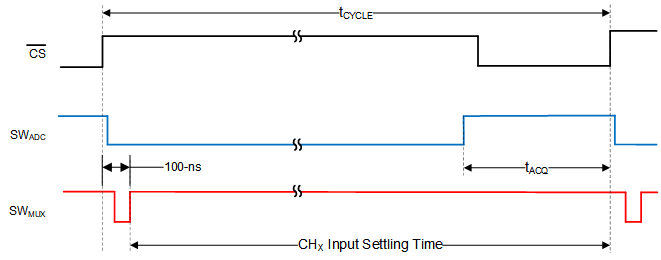SBAS817C November 2017 – November 2019 ADS8166 , ADS8167 , ADS8168
PRODUCTION DATA.
- 1 Features
- 2 Applications
- 3 Description
- 4 Revision History
- 5 Pin Configuration and Functions
- 6 Specifications
-
7 Detailed Description
- 7.1 Overview
- 7.2 Functional Block Diagram
- 7.3 Feature Description
- 7.4 Device Functional Modes
- 7.5 Programming
- 7.6
Register Maps
- 7.6.1
Interface and Hardware Configuration Registers
- 7.6.1.1 REG_ACCESS Register (address = 00h) [reset = 00h]
- 7.6.1.2 PD_CNTL Register (address = 04h) [reset = 00h]
- 7.6.1.3 SDI_CNTL Register (address = 008h) [reset = 00h]
- 7.6.1.4 SDO_CNTL1 Register (address = 0Ch) [reset = 00h]
- 7.6.1.5 SDO_CNTL2 Register (address = 0Dh) [reset = 00h]
- 7.6.1.6 SDO_CNTL3 Register (address = 0Eh) [reset = 00h]
- 7.6.1.7 SDO_CNTL4 Register (address = 0Fh) [reset = 00h]
- 7.6.1.8 DATA_CNTL Register (address = 10h) [reset = 00h]
- 7.6.1.9 PARITY_CNTL Register (address = 11h) [reset = 00h]
- 7.6.2 Device Calibration Registers
- 7.6.3 Analog Input Configuration Registers
- 7.6.4
Channel Sequence Configuration Registers Map
- 7.6.4.1 DEVICE_CFG Register (address = 1Ch) [reset = 00h]
- 7.6.4.2 CHANNEL_ID Register (address = 1Dh) [reset = 00h]
- 7.6.4.3 SEQ_START Register (address = 1Eh) [reset = 00h]
- 7.6.4.4 SEQ_ABORT Register (address = 1Fh) [reset = 00h]
- 7.6.4.5 ON_THE_FLY_CFG Register (address = 2Ah) [reset = 00h]
- 7.6.4.6 AUTO_SEQ_CFG1 Register (address = 80h) [reset = 00h]
- 7.6.4.7 AUTO_SEQ_CFG2 Register (address = 82h) [reset = 00h]
- 7.6.4.8
Custom Channel Sequencing Mode Registers
- 7.6.4.8.1 CCS_START_INDEX Register (address = 88h) [reset = 00h]
- 7.6.4.8.2 CCS_END_INDEX Register (address = 89h) [reset = 00h]
- 7.6.4.8.3 CCS_SEQ_LOOP Register (address = 8Bh) [reset = 00h]
- 7.6.4.8.4 CCS_CHID_INDEX_m Registers (address = 8C, 8E, 90, 92, 94, 96, 98, 9A, 9C, 9E, A0, A2, A4, A6, A8, and AAh) [reset = 00h]
- 7.6.4.8.5 REPEAT_INDEX_m Registers (address = 8D, 8F, 91, 93, 95, 97, 99, 9B, 9D, 9F, A1, A3, A5, A7, A9, and ABh) [reset = 00h]
- 7.6.5
Digital Window Comparator Configuration Registers Map
- 7.6.5.1 ALERT_CFG Register (address = 2Eh) [reset = 00h]
- 7.6.5.2 HI_TRIG_AINx[15:0] Register (address = 4Dh to 30h) [reset = 0000h]
- 7.6.5.3 LO_TRIG_AINx[15:0] Register (address = 71h to 54h) [reset = 0000h]
- 7.6.5.4 HYSTERESIS_AINx[7:0] Register (address = 4Fh to 33h) [reset = 00h]
- 7.6.5.5 ALERT_LO_STATUS Register (address = 78h) [reset = 00h]
- 7.6.5.6 ALERT_HI_STATUS Register (address = 79h) [reset = 00h]
- 7.6.5.7 ALERT_STATUS Register (address = 7Ah) [reset = 00h]
- 7.6.5.8 CURR_ALERT_LO_STATUS Register (address = 7Ch) [reset = 00h]
- 7.6.5.9 CURR_ALERT_HI_STATUS Register (address = 7Dh) [reset = 00h]
- 7.6.5.10 CURR_ALERT_STATUS Register (address = 7Eh) [reset = 00h]
- 7.6.1
Interface and Hardware Configuration Registers
- 8 Application and Implementation
- 9 Power Supply Recommendations
- 10Layout
- 11Device and Documentation Support
- 12Mechanical, Packaging, and Orderable Information
Package Options
Mechanical Data (Package|Pins)
- RHB|32
Thermal pad, mechanical data (Package|Pins)
- RHB|32
Orderable Information
7.3.1.3 Early Switching for Direct Sensor Interface
Figure 33 shows the small-signal equivalent model of the ADS816x analog inputs. The multiplexer input has a switch resistance (RMUX) and parasitic capacitance (CMUX). The parasitic capacitance causes a charge kickback on the MUX analog input at the same time as the ADC sampling capacitor causes a charge kickback on ADC inputs.
 Figure 33. Synchronous and Timed Switching of the MUX and ADC Input Switches
Figure 33. Synchronous and Timed Switching of the MUX and ADC Input Switches In conventional multichannel SAR ADCs, the acquisition time of the ADC is also the settling time available at the analog inputs of the multiplexer because these times are internally connected. Thus, high-bandwidth op amps are required at the analog inputs of the multiplexer to settle the charge kickback. However, multiple high-bandwidth op amps significantly increase power dissipation, cost, and size of the solution.
The analog inputs of the ADS816x provide a long settling time (tCYCLE – 100 ns), resulting in long acquisition time at the MUX inputs when using a driver amplifier between the MUX outputs and the ADC inputs. Figure 34 shows a timing diagram of this long acquisition phase. The low parasitic capacitance together with the enhanced settling time eliminate the need to use an op amp at the multiplexer input in most applications.
 Figure 34. Early Switching of the MUX Enables a Long Acquisition Phase
Figure 34. Early Switching of the MUX Enables a Long Acquisition Phase Averaging several output codes of a particular MUX input channel without switching the MUX achieves better accuracy and noise performance. The output of the multiplexer does not create a charge kickback as long as SDI is set to 0 (that is, as long as SDI returns the NOP command); see Figure 43 and Figure 45. The multiplexer does not switch during subsequent conversions except for the first time when a channel is selected. Thus high-impedance sources (such as the voltage from the resistor dividers) can be connected to the analog inputs of the multiplexer without an op amp.